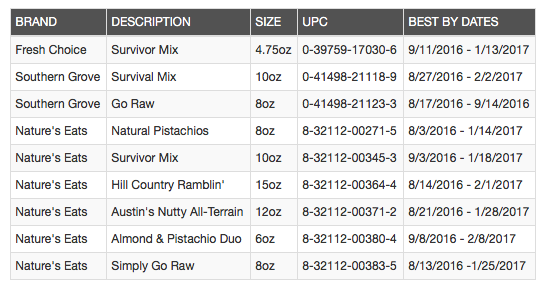Chapman has written about his obsession with low moisture foods and how he terrifies his children about Salmonella in chocolate.
Now he has a month worth of bedtime reading: The Microbiological Safety of Low Water Activity Foods and Spices
Gurtler, Joshua B., Doyle, Michael P., Kornacki, Jeffrey L. (Eds.)
http://www.springer.com/food+science/book/978-1-4939-2061-7
 Describes the microbial challenges to ensuring the safety of low water activity (aw) food
Describes the microbial challenges to ensuring the safety of low water activity (aw) food
Gives insight into regulatory issues, and appropriate product sampling and testing methods
Explores the efficacy of industrially-used and potential product decontamination interventions
Low water activity (aw) and dried foods such as dried dairy and meat products, grain-based and dried ready-to-eat cereal products, powdered infant formula, peanut and nut pastes, as well as flours and meals have increasingly been associated with product recalls and foodborne outbreaks due to contamination by pathogens such as Salmonella spp. and enterohemorrhagic E. coli.
In particular, recent foodborne outbreaks and product recalls related to Salmonella-contaminated spices have raised the level of public health concern for spices as agents of foodborne illnesses.
Presently, most spices are grown outside the U.S., mainly in 8 countries: India, Indonesia, China, Brazil, Peru, Madagascar, Mexico and Vietnam. Many of these countries are under-developed and spices are harvested and stored with little heed to sanitation. The USDA has regulatory oversight of spices in the United States; however, the agency’s control is largely limited to enforcing regulatory compliance through sampling and testing only after imported foodstuffs have crossed the U.S. border. Unfortunately, statistical sampling plans are inefficient tools for ensuring total food safety. As a result, the development and use of decontamination treatments is key.
 This book provides an understanding of the microbial challenges to the safety of low aw foods, and a historic backdrop to the paradigm shift now highlighting low aw foods as vehicles for foodborne pathogens. Up-to-date facts and figures of foodborne illness outbreaks and product recalls are included. Special attention is given to the uncanny ability of Salmonella to persist under dry conditions in food processing plants and foods. A section is dedicated specifically to processing plant investigations, providing practical approaches to determining sources of persistent bacterial strains in the industrial food processing environment. Readers are guided through dry cleaning, wet cleaning and alternatives to processing plant hygiene and sanitation. Separate chapters are devoted to low aw food commodities of interest including spices, dried dairy-based products, low aw meat products, dried ready-to-eat cereal products, powdered infant formula, nuts and nut pastes, flours and meals, chocolate and confectionary, dried teas and herbs, and pet foods.
This book provides an understanding of the microbial challenges to the safety of low aw foods, and a historic backdrop to the paradigm shift now highlighting low aw foods as vehicles for foodborne pathogens. Up-to-date facts and figures of foodborne illness outbreaks and product recalls are included. Special attention is given to the uncanny ability of Salmonella to persist under dry conditions in food processing plants and foods. A section is dedicated specifically to processing plant investigations, providing practical approaches to determining sources of persistent bacterial strains in the industrial food processing environment. Readers are guided through dry cleaning, wet cleaning and alternatives to processing plant hygiene and sanitation. Separate chapters are devoted to low aw food commodities of interest including spices, dried dairy-based products, low aw meat products, dried ready-to-eat cereal products, powdered infant formula, nuts and nut pastes, flours and meals, chocolate and confectionary, dried teas and herbs, and pet foods.
The book provides regulatory testing guidelines and recommendations as well as guidance through methodological and sampling challenges to testing spices and low aw foods for the presence of foodborne pathogens. Chapters also address decontamination processes for low aw foods, including heat, steam, irradiation, microwave, and alternative energy-based treatments.
 The majority of LMF are not cooked prior to consumption so contamination at the time of manufacture could lead to illness when consumed by the soldier. In addition, military rations are prepositioned and can be stored for up to 3 years at various climate conditions therefore, this study evaluated various storage temperatures to simulate conditions in the field. LMF products in this study were chosen based on categories outlined by Institute of Food Safety and Health peanut butter, mocha desert bar, dehydrated egg, chocolate protein drink and cran-raspberry first strike bar.
The majority of LMF are not cooked prior to consumption so contamination at the time of manufacture could lead to illness when consumed by the soldier. In addition, military rations are prepositioned and can be stored for up to 3 years at various climate conditions therefore, this study evaluated various storage temperatures to simulate conditions in the field. LMF products in this study were chosen based on categories outlined by Institute of Food Safety and Health peanut butter, mocha desert bar, dehydrated egg, chocolate protein drink and cran-raspberry first strike bar.





